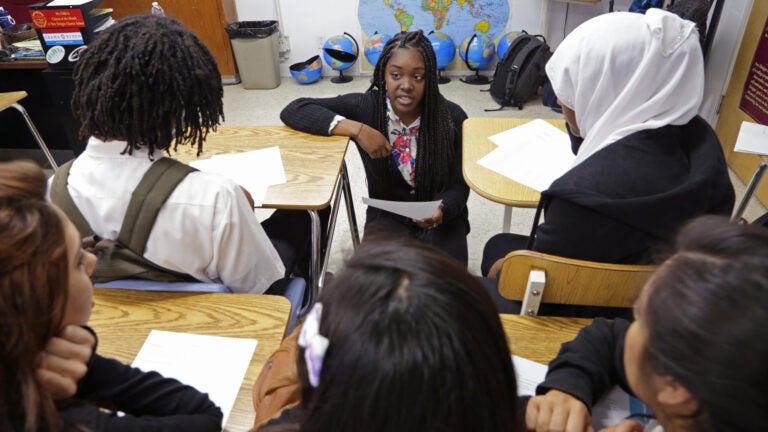
USC Dornsife junior Cashae Ellis discusses 2016 ballot measures with high school students studying local government. (Photo/Mike Glier)
Civic engagement program offers lessons to high school students
USC Dornsife undergrads teach teens about politics and the value of voting
Despite most being bilingual themselves, six New Designs Charter Schools students finished their group discussion on California’s Multilingual Education Act, split on whether languages other than English should be used for instruction in public schools.
The conversation centered on whether the act, a ballot measure coming up in November, could help students who grew up in Spanish-speaking families to receive homework in their native tongue — or hinder them because they might not have the language skills to keep up in advanced-placement classes in high school or college seminars.
“I think it could be a problem if kids are taught math and science in Spanish when they are in elementary school and then want to transition into higher level classes later on,” said one of the students.
All seniors studying government at New Designs Charter Schools are participating in an eight-week program on civic engagement taught by USC undergraduates. The internship program, conceived as a partnership between the Jesse M. Unruh Institute of Politics and the Joint Educational Project, seeks to engage teenagers in local politics and motivate them to believe that civic participation can make a difference.
We wanted to connect students to the issues in their communities that matter to them.
Alexandra Bissonnette
“We wanted to connect students to the issues in their communities that matter to them and show them how becoming civically engaged can move the needle on important issues,” said Alexandra Bissonnette, deputy director of the Jesse M. Unruh Institute of Politics. “Also, since we know that the best way to motivate someone is to have them motivate someone else, our USC students end up getting excited about the prospect of making change.”
Giving them some credit
The Civic Engagement Teaching Internship is offered for credit as a political science course, although some undergraduates participate as volunteers. The program, which launched last fall, currently includes six USC students working in two high schools. The curriculum comprises eight hourlong sessions on topics such as 2016 ballot measures and the key issues of each candidate in local senate and congressional races.
Pooyan Jamneshan, a senior majoring in philosophy, politics and law, is co-teaching the course at New Designs Charter Schools.
“The students are always willing to participate, and they seem genuinely interested in the material,” he said.
Cashae Ellis, who is partnering with Jamneshan, has an academic and a personal investment in the program.
“I grew up here, so I know that students don’t get a lot of education and awareness about civic engagement and local politics,” said Ellis, a junior majoring in sociology. “So I wanted to give back by teaching it to them.”
Ultimately, the Civic Engagement Teaching Internship aims to increase voter turnout and civic participation in Los Angeles.
“During a time in which we deeply question why civic participation is so low, I don’t see this just as a national problem. I see it as an LA problem,” said Catherine Shieh, a staff associate at the Unruh Institute who oversees the program. “Our hope is that if we educate our youth on practical and essential information about voting and find personal reasons for them to be politically involved, the buy-in from both USC students and local teenagers will be lasting.”
While some of the students will be eligible to vote during the next election, many will not. However, Bissonnette emphasized that this program can benefit everyone.
“Even if you’re not able to vote — whether it’s because you’re too young or aren’t a legal resident — you can become civically engaged, advocate on behalf of a candidate or cause and persuade others to participate in elections,” she said. “We tell the kids, ‘If you can help turn out five people on Election Day, it’s as if you’ve voted five times.’”
